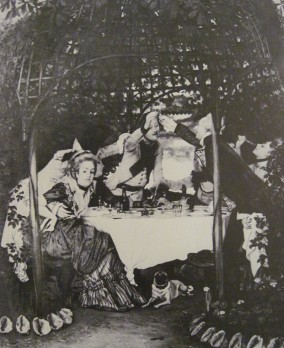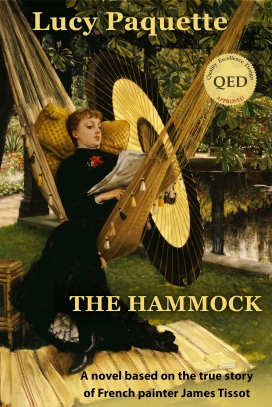To cite this article: Paquette, Lucy. Tissot around the world: India, Japan, Australia & New Zealand. The Hammock. https://thehammocknovel.wordpress.com/2013/06/20/tissot-around-the-world-india-japan-australia-new-zealand/. <Date viewed.>
While James Tissot is hardly a household name, his work is popular all over the world and can be found in some unexpected places.
India

Partie Carée/The Foursome (1870), by James Tissot. (Photo: Wikimedia.org)
Tissot’s Vive la République! (Un souper sous le Directoire) is similar to Partie Carée/The Foursome, exhibited at the 1870 Salon, in which he depicts a gentleman on the left grasping his date’s right breast, while the woman across from them downs a glass of champagne at the side of another delighted young man.
In Vive la République!, there are three couples, including the fondling gentleman  and his date on the left and the champagne-drinking woman on the right, and the two men with their hands free are toasting over an outdoor luncheon table shaded by a dome-shaped wooden trellis. A pug dog looks out from under the table.
and his date on the left and the champagne-drinking woman on the right, and the two men with their hands free are toasting over an outdoor luncheon table shaded by a dome-shaped wooden trellis. A pug dog looks out from under the table.
While working in Paris in the late 1860s, Tissot painted a series of nine 18th century scenes, set in the French Directory period (1795 to 1799). A few of these pictures were sexually suggestive, but in this quaint setting, they did not offend contemporary morals. Tissot’s Vive la République!, c. 1870, is possibly a sly reference to the new republican government declared in France on September 4, 1870, after Napoléon III’s surrender to the Prussians. This celebratory scene made its way to India, where it is now in the collection of the Baroda Museum and Picture Gallery in Vadodara, Gujarat.

Baroda Museum and Picture Gallery (Photo: Wikipedia.org)

Sayajirao III Gaekwad, Maharaja of Baroda, November 26, 1919 (Photo: Wikimedia.org)
The museum – which resembles London’s Victoria and Albert Museum – was founded in 1887 by the Maharaja of what was then Baroda State (Sayajirao Gaekwad III, 1863 – 1939), for the education of his subjects.
Construction of the picture gallery, a separate building, began in 1908, but it was opened in 1921 because of delays bringing art from Europe during World War I.
The interiors and exteriors of both buildings were scheduled for major restoration in 2012, as the city of Vadodara prepared to celebrate the 150th anniversary of the birth of Sayajirao Gaekwad III.
Japan
One of the most dazzling exhibits at the 1867 Paris International Exposition was the Japanese Pavilion, and it received more visitors than any other exhibit. This was the first World’s Fair in which Japan participated.

Tokugawa Akitake, 1867 (Photo: Wikimedia.org)
The Japanese Imperial Commission to the Exposition was led by fourteen-year-old Prince Tokugawa Akitake (1853-1910), a younger brother of the man who would be the last Shogun under Japan’s feudal regime.
The delegation arrived in Paris in March, 1867, and one year later, James Tissot was appointed gwa-gaku, or drawing master, to Prince Akitake. (This fact was revealed in December, 1979, at the International Symposium in Tokyo.)
Prince Akitake made several visits to Tissot’s studio over the course of the seven- or eight-month appointment, and Tissot painted his portrait in water-color mounted on a hanging scroll on September 27, 1868. Now at the Historical Museum of the Tokugawa Family, Mito, Japan, it wasn’t until about 1968 that the painter of this picture was identified, by a Japanese scholar, as James Tissot. To see it, click here.
To read more about James Tissot and Prince Akitake, click here. To read more about Tissot’s japonisme, click here.
Australia

An Interesting Story (c. 1872), by James Tissot. (Photo: Wikimedia.org)

Theresa Parker (1787), by Sir Joshua Reynolds. 75 by 62 cm., Henry E. Huntington Art Gallery, San Marino, CA, USA (Photo: Wikipaintings.org)
An interesting story (c. 1872), entered the collection of the National Gallery of Victoria, Melbourne, Australia with the Felton Bequest in 1938.
In Paris, Tissot had painted a series of pictures set in the French Directoire period, 1795-99.
After he fled to London in mid-1871, he adapted his setting to suit English tastes, modeling his 18th century style pictures on portraits by Sir Joshua Reynolds (1723 – 1792), a co-founder of the Royal Academy.
Tissot bought original 18th century English costumes in second-hand shops and used them in various combinations with different models.
In An interesting story, he showcased his expertise painting ship’s rigging – using the Thames as the background to make his art relevant to British patrons – while offering his own brand of humor. Those poor women! Their patient suffering surely transcends cultures.

The Widower, by James Tissot (Photo: Wikimedia.org)
The Widower (1876) was set in Tissot’s garden in St. John’s Wood, London. The painting belonged to J.P. Davis by 1877 and to John H. Downes by 1888. By 1939, it was in the possession of Sir Colin and Lady Morna Anderson, who gifted it to the Art Gallery of New South Wales in Sydney, Australia. Included in the exhibition, “James Tissot: Victorian Life / Modern Love,” The Widower was on display at the Yale Center for British Art in New Haven, Connecticut in the fall of 1999, the Musée de Québec in Quebec City during the winter of 1999-2000 and the Albright-Knox Art Gallery in Buffalo, New York in the spring and summer of 2000. It also has been exhibited many times in Japan and twice at the Auckland Art Gallery Toi o Tāmaki in New Zealand.
New Zealand
Waiting for the Train (Willesden Junction) (c. 1871-73) was purchased in 1921, with £89 5s from the Thomas Brown Fund, for the Dunedin Public Art Gallery in New Zealand.
Willesden Junction is in northwest London, and was brand-new when Tissot painted it, complete with its rubbish bin. The West Coast Main Line station was opened at Willesden Junction by the London & North Western Railway in 1866, with trains traveling to Birmingham and Scotland. The upper level station on the North London Line was opened in 1869 by the North London Railway, which ran trains east-west across Northern London.
The modern woman portrayed in this ultra-modern setting looks at us with a direct, confidence gaze amid her baggage. It’s a small but fascinating painting, suffused with a delightful ambiguity typical of Tissot. Who is this woman, and where is she going? She seems free-spirited, yet she is enclosed in a jumble of cramped spaces. With his sly and original humor, Tissot signed one of her suitcases with his monogram, J.J. Her purse clasp bears his monogram as well, but it’s hard to see in a reproduction. The picture is a tiny Tissot treasure.

Still on Top (c. 1874), by James Tissot. Oil on canvas, 88 by 54 cm. (Photo: Wikipaintings)
Tissot’s Still on Top (c. 1874), is in the collection of the Auckland Art Gallery Toi o Tāmaki in New Zealand, the gift of British industrialist and politician Viscount Leverhulme (1851 – 1925) in 1921, when it was worth approximately £ 500. Still on Top depicts two women and an elderly male servant wearing a red liberty cap, a revolutionary symbol in France. It had only been three years since Tissot had fled Paris – under some suspicion – during the French government’s suppression of the radical Paris Commune. It’s really rather daring for an apparent French political refugee of the time, remaking his career in England: as the three figures raise the flags, which is on top?
Painted in Tissot’s extensive garden at his home in St. John’s Wood, London, the picture is similar to his Preparing for the gala, which came up for auction at Sotheby’s, New York in May, 1996. Preparing for the Gala sold for $1,650,000/£ 1,090,188.
On the morning of Sunday, August 9, 1998, the slightly larger Still on Top, worth $3.5 million USD, was stolen from the Auckland Art Gallery by a 48-year-old man with a shotgun who then asked $260,000 ransom from the Auckland Art Gallery. The painting was recovered under a bed at the home the man rented in Waikaretu, south of Port Waikato, on August 17. Restoration of the picture, which had been terribly damaged, began in February 1999. [For the full story of the robbery – including surveillance video – and the repairs to Still on Top, click here.]
The restored work was unveiled at the gallery on July 12, 2001 at a special exhibition that included Tissot’s Waiting for the Train (Willesden Junction) from New Zealand’s Dunedin Public Art Gallery and The Widower from the Art Gallery of New South Wales in Sydney, Australia.
In 2006, Preparing for the Gala was sold at Christie’s, London for $ 2,763,150/£ 1,500,000.
© 2013 by Lucy Paquette. All rights reserved.
The articles published on this blog are copyrighted by Lucy Paquette. An article or any portion of it may not be reproduced in any medium or transmitted in any form, electronic or mechanical, without the author’s permission. You are welcome to cite or quote from an article provided you give full acknowledgement to the author.
 If you do not have a Kindle e-reader, you may download free Kindle reading apps for PCs, Smartphones, tablets, and the Kindle Cloud Reader to read The Hammock: A novel based on the true story of French painter James Tissot. Read reviews.
If you do not have a Kindle e-reader, you may download free Kindle reading apps for PCs, Smartphones, tablets, and the Kindle Cloud Reader to read The Hammock: A novel based on the true story of French painter James Tissot. Read reviews.
The Hammock: A novel based on the true story of French painter James Tissot, brings Tissot’s world from 1870 to 1879 alive in a story of war, art, Society glamour, love, scandal, and tragedy.
Illustrated with 17 stunning, high-resolution fine art images in full color
Courtesy of The Bridgeman Art Library
(295 pages; ISBN (ePub): 978-0-615-68267-9). See http://www.amazon.com/dp/B009P5RYVE.